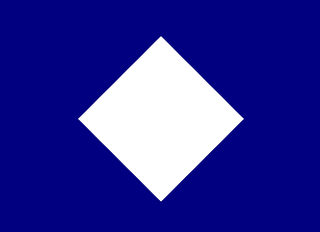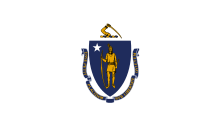
The 28th Massachusetts Infantry regiment was the second primarily Irish American volunteer infantry regiment recruited in Massachusetts for service in the American Civil War. The regiment's motto was Faugh a Ballagh
The 3rd Massachusetts Volunteer Heavy Artillery Regiment was a unit that served in the Union Army during the American Civil War. It was organized from already mustered unattached companies of heavy artillery raised for the defenses of the Massachusetts coast.
The 1st Battalion of Massachusetts Volunteer Heavy Artillery was a unit that served in the Union Army during the American Civil War. It was organized from several unattached companies of heavy artillery already raised and mustered into a three-year service for the defenses of the Massachusetts coast.
The 61st Regiment Massachusetts Volunteer Infantry was an infantry regiment raised for one year's service in the Union Army during the American Civil War from 1864 to 1865.

The 7th Regiment Massachusetts Volunteer Infantry was an infantry regiment in the Union army during the American Civil War. It was formed on June 15, 1861, in Taunton. Its original commander was Colonel Darius N. Couch who would eventually be promoted to command the II Corps of the Army of the Potomac and, after that, the Department of the Susquehanna.

The 16th Massachusetts was an infantry regiment that served in the Union Army during the American Civil War formed of volunteers from the Commonwealth of Massachusetts.

The 3rd Massachusetts Battery, was an artillery battery that served in the Union Army during the American Civil War.
The 9th Massachusetts Battery was a field artillery battery that served in the Union Army during the American Civil War.

The 5th Regiment Massachusetts Volunteer Militia was a peacetime infantry regiment that was activated for federal service in the Union army for three separate tours during the American Civil War. In the years immediately preceding the war and during its first term of service, the regiment consisted primarily of companies from Essex County as well as Boston and Charlestown.

The 1st Massachusetts Battery was a peacetime militia artillery battery that was activated for federal service in the Union army for two separate tours during the American Civil War. Prior to the war and during its first term of service, the unit was sometimes known as "Cook's Battery" after its commanding officer, Capt. Asa M. Cook. During its first term, the battery primarily served garrison duty in Baltimore, Maryland. Almost immediately after mustering out, the unit began preparing for a second term, this time volunteering to serve for three years. The battery was attached to the VI Corps of the Army of the Potomac during its second term and took part in some of the largest battles of the war including the Fredericksburg, Chancellorsville, Gettysburg, and Lieutenant General Ulysses S. Grant's Overland Campaign in the spring of 1864.

The 2nd Massachusetts Battery was an artillery battery that served in the Union army during the American Civil War. The unit was initially known as "Cobb's Light Artillery" for its first commander, Major Moses Cobb. An experienced officer of the Massachusetts militia, Cobb was selected to organize and command the battery on April 20, 1861, however he did not go with the unit when it departed for the field. The unit was later known as "Nim's Battery" after its subsequent commanding officer, Capt. Ormand F. Nims. It was one of the Massachusetts regiments organized in response to President Abraham Lincoln's call on May 2, 1861, for volunteer troops to serve a term of three-years. The 2nd Massachusetts Battery was the first unit of artillery to be recruited in Massachusetts for three-years service. The battery trained at Camp Adams in Quincy, Massachusetts, and was mustered into federal service on July 31, 1861.

The 4th Massachusetts Battery was an artillery battery that served in the Union Army during the American Civil War. The unit was sometimes known as "Manning's Battery" after its commanding officer, Capt. Charles H. Manning. It was one of the Massachusetts regiments organized in response to President Abraham Lincoln's call on May 2, 1861 for volunteer troops to serve a term of three-years. The core of the unit was a peace-time militia company known as the Salem Light Artillery. The battery trained at Camp Chase in Lowell, Massachusetts. It was assigned to the Department of the Gulf under Major General Benjamin F. Butler and departed Boston by steamship on November 20.

The 5th Massachusetts Battery was an artillery battery that served in the Union army during the American Civil War. It was one of the Massachusetts regiments organized in response to President Abraham Lincoln's call on May 2, 1861 for volunteer troops to serve a term of three-years. The battery trained at Camp Shouler in Lynnfield, Massachusetts and Camp Massasoit in Readville, Massachusetts. It departed Boston by steamship on December 25, 1861.

The 6th Massachusetts Battery was an artillery battery that served in the Union Army during the American Civil War. The unit was one of the Massachusetts regiments organized in response to President Abraham Lincoln's call on May 2, 1861 for volunteer troops to serve a term of three-years. The battery trained at Camp Chase in Lowell, Massachusetts. It was assigned to the Department of the Gulf under Major General Benjamin F. Butler and departed Boston by steamship on February 8, 1862. At that time, the unit comprised 145 men armed with two rifled and four smoothbore six-pounder field guns.

The 7th Massachusetts Battery was an artillery battery that served in the Union Army during the American Civil War. The original core of the unit was a company of infantry known as the Richardson Light Guard. The company initially served provost duty at Fortress Monroe, was eventually trained in light artillery drill, and reorganized on March 17, 1862 as the 7th Massachusetts Battery.

The 11th Massachusetts Battery was an artillery battery that served in the Union Army during the American Civil War. It was formed in response to President Abraham Lincoln's August 1862 call for 300,000 men to serve for nine months. Several months after completing their first term of service, the battery was reorganized for a second term of three years. It was recruited by Captain Edward J. Jones of Boston and consisted almost entirely of men from that city. The battery served a largely uneventful first term as garrison troops mostly in Centreville, Virginia. During their second term they were involved in heavy combat being part of the Army of the Potomac during Lieutenant General Ulysses S. Grant's Overland Campaign.

The 12th Massachusetts Battery was an artillery battery that served in the Union Army during the American Civil War. The unit was organized at Camp Meigs near Boston during the fall of 1862. Its members were mustered in at various times over the fall and the officers mustered into federal service on December 8, 1862. It was assigned to the Department of the Gulf under Major General Nathaniel P. Banks and departed Massachusetts by steamship on January 3, 1863.

The 13th Massachusetts Battery was an artillery battery that served in the Union Army during the American Civil War. The unit was organized at Camp Meigs near Boston during the fall of 1862. Its members were mustered in at various times over the fall and the officers mustered into federal service on November 3, 1862. It was assigned to the Department of the Gulf commanded by Major General Nathaniel P. Banks and departed Massachusetts by steamship on January 20, 1863.

The 14th Massachusetts Battery was an artillery battery that served in the Union Army during the American Civil War. It was organized during the winter of 1863 - 1864 at Camp Meigs just outside of Boston. It was commanded by Captain Joseph W. B. Wright of Boston and consisted mostly of men from that city. The enlisted men were mustered into federal service on February 27, 1864. They departed Massachusetts on April 4, 1864, arrived at Annapolis and then moved to Camp Marshall in Washington, D.C. On April 22 and 24 they were outfitted with field guns and horses but had virtually no time to train in light artillery tactics before they were assigned to the IX Corps of the Army of the Potomac and joined Lieutenant General Ulysses S. Grant's Overland Campaign.

The 15th Massachusetts Battery was an artillery battery that served in the Union Army during the American Civil War. The unit was organized partly at Camp Chase in Lowell, Massachusetts and partly at Fort Warren during the winter of 1862-1863. The majority of its members were mustered into federal service on February 17, 1863. It was assigned to the Department of the Gulf commanded by Major General Nathaniel P. Banks and departed Massachusetts by steamship on March 9. During its term, the unit suffered from a large number of desertions and gained an unfortunate reputation despite the service of its many loyal members.








